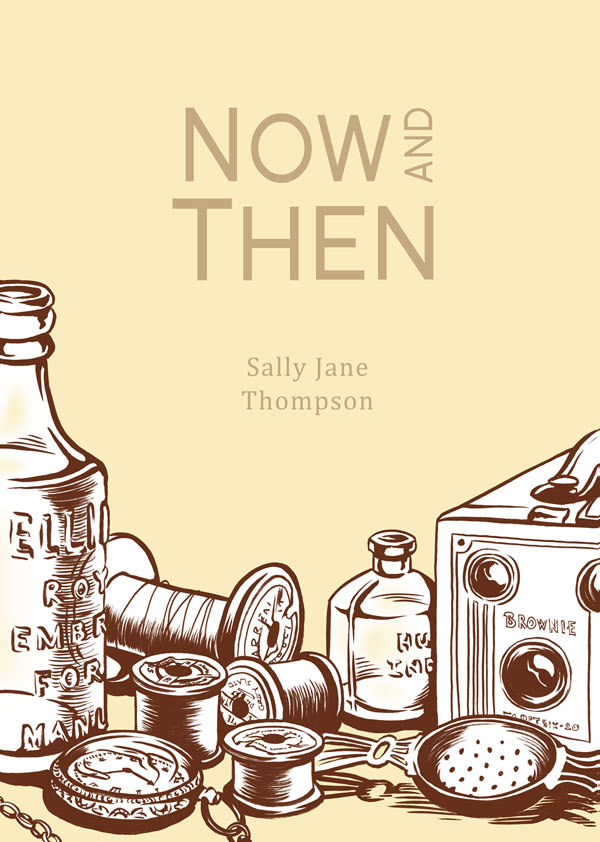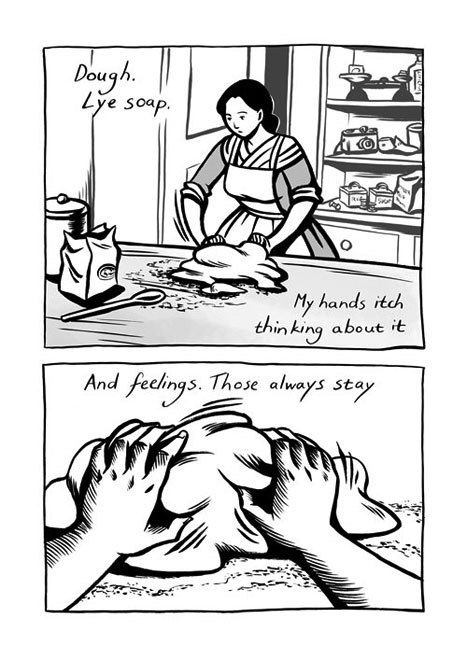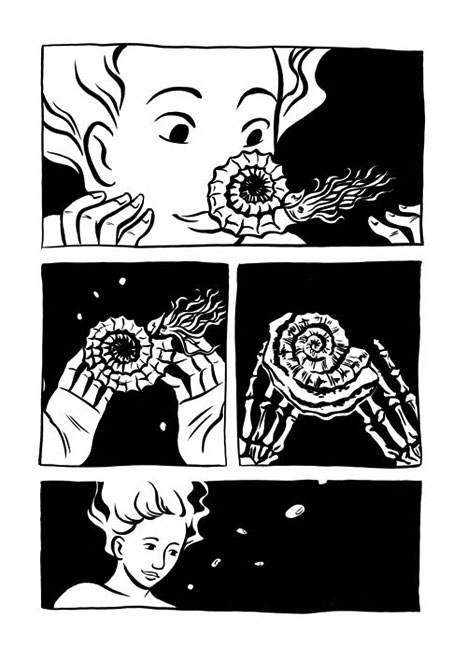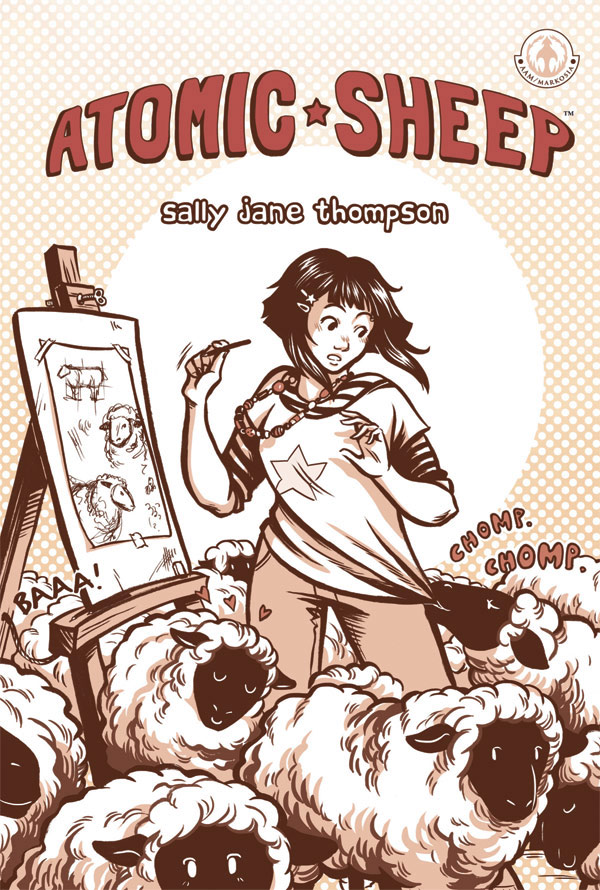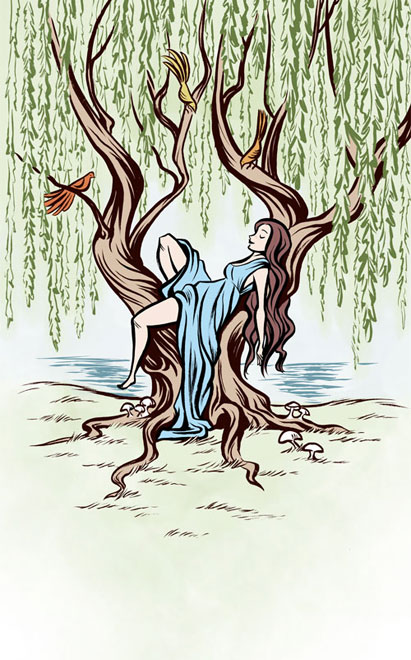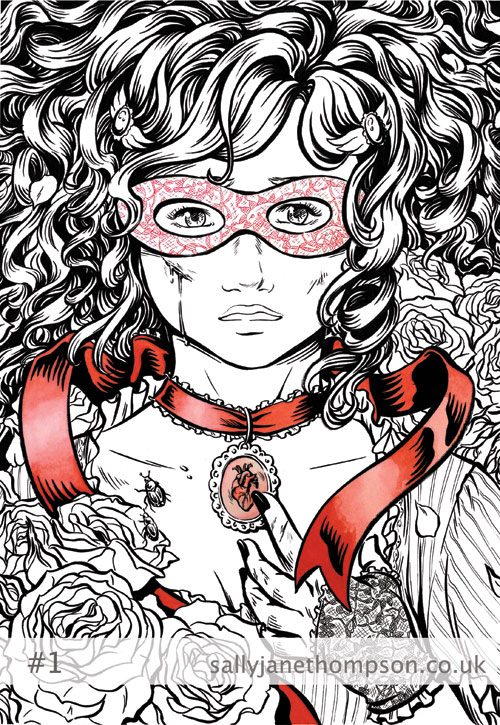Sally Jane Thompson is one of the more brilliant lights in the comics industry, a multi-talented creator who can turn her hand to anything: writing, pencilling, lettering, portraiture, blogging, colouring. A constant bright presence at conventions around the UK, she is perhaps most well-known for her graphic novel Atomic Sheep and her portrait series Blood and Roses.
This week sees her comic Now and Then hit the internet, which you can get your hands on right now for $1. Only a dollar! How is that not the greatest deal you ever heard? To celebrate the release of Now and Then, she was kind enough to chat with me about the project, her creative process, developing as a creator and more.
Steve: Now and Then is a comic about England, and generations, and history. What prompted the story?
Sally: Now and Then was very much inspired by my own experiences, having moved to England and being constantly amazed by the very real and practical presence of the past everywhere! Short stories often come about for me in a similar way to a poem (I’m hoping that doesn’t sound pretentious! I used to write a lot more poetry than I do now that comics have consumed my brain, and realized the other day that the initial idea development was very much the same).
Something I come across, some instance or image – usually something visual – will strike me as having some resonance to it, something where it could connect to a concept or feeling beyond the image itself. In this case, I had the opening images of the woman floating with ammonites in the sea, and the hand turning to bone, pop into my head, and realized that that could link to my interest in the lived nature of history.
Steve: How do your stories come together from that point? I always find it interesting if a writer/artist finds that they tend to lead from their artistic or literary side, and how they balance the two.
Sally: Ah, I’ve gotten a little ahead of myself on that last question! To continue that line of thought, it’s usually generating from an instance, something I notice or occurs to me while I’m going about my day, and then something wider that it plugs into. Sometimes what that is occurs to me immediately, other times I just file that image away in my head, and maybe it’ll connect with something later on.
So usually it’s story-led…by the time I get to any sketching, I know what I’m trying to get across, so even the visual element is still, in a way, writing. But I do standalone sketches and illustrations in my spare time, and sometimes those mushroom into something bigger too! And I don’t write a text script – I script in tiny, messy thumbnails with dialogue notes scribbled alongside, so it’s mixed from the start.
Steve: A lot of your comics incorporate the lettering as part of the artwork, establishing tone. How do you go about lettering your work?
Sally: I’m working on improving my hand-lettering, because I do think it’s the most organic fit, as the writing is a visual element on the page. I’m not quite neat enough yet to use it for longer, wordier comics, but comics like this are a perfect fit for it. Speech bubbles and hand-lettered sound effects are worked in from thumbnail stage, because it’s all part of the composition. I’ll definitely continue to experiment (and hopefully improve) at integrating more thoughtful and creative typography into my pages!
Steve: It’s a comic which seems very tactile, even while reading it digitally. Was this an intention of yours, to try and express pointedly a sense of physicality and reality?
Sally: Funnily enough, I specifically wanted to try and create something that would read well digitally – with few panels and large enough text that it could be read comfortably even on a small e-reader. So it’s really interesting – and lovely – that you found it tactile, especially given how that ties in to the story! I think that probably comes from the art, the ink-on-paper feel coming through – and my drawing in this one had quite a strong influence from linocuts and similar media.
Steve: One thing which stands out in all your work is a sense of place. From! Is set during a trip through your home of South Africa, whilst Now and Then is firmly set in Derbyshire. To what extent does location inform your writing?
Sally: I think comics are incredibly well-suited to communicating a sense of place and atmosphere, with the ability to vary pacing and focus, from wide vistas that slow the reader down, to small, well-observed details. I’ve moved around quite a bit, and so the feeling of the space I’m in is something that I tend to think about a lot. The location isn’t always important to my stories, especially shorter ones where it’s more about an idea, but I do always want my stories to feel like they exist in a real space that has some feeling or mood to it, to feel grounded in that way.
Steve: This last year gone has been noticeably prolific for you. How do you process your workload? Do you prefer to keep several things juggling at once, or settle on one project at a time?
Sally: I struggle to balance that, personally, as I find it refreshing to have a couple of things on the go and switch to one when I’m feeling a bit stale on the other…but on the other hand, I find it frustrating when I have to switch all the time, and don’t have enough time to get my head into the right space for a project. A lot of my freelance work tends to be smaller projects, so I’ve gotten used to juggling quite a bit, although my life (and home) are rather chaotic!
It’s a goal of mine to get more work on larger projects, so I can have just two or three things on the go at once, and be able to really get properly into them!
Steve: Atomic Sheep, which came out last year, was one of – if not the – biggest projects you’ve worked on to date. What inspired the story, and what made you choose to follow it as a graphic novel?
Sally: I actually started thinking about Atomic Sheep way back near the start of my undergraduate degree, and I think a big impetus was the slice-of-life, school-based sort of manga I was reading at the time – things like Ai Yazawa’s Paradise Kiss. I wanted to do something about the sort of things I was thinking about at the time – finding direction, being your own person, being intentional about your life. It has a fair amount of characters being quite reflective, and I was realizing that comics were fantastic for communicating that.
It was a learning book for me– it had to be shelved for some fairly long periods while I finished my MA, started freelancing, and got married – and when I knuckled down to finish it I had to re-do a number of things because I’d gotten much better in the intervening time! But the way comics pacing and layouts can convey emotions and atmosphere and reflection has been very steady for me, in that it was what drew me to start Atomic Sheep way back then, and is still a cornerstone of my work.
Steve: It was published by Markosia, who are one of many well-regarded publishers in the UK. How was the pitching process? And how do you feel about the British comics scene as a whole? Is it getting easier to have your work seen in the UK?
Sally: Markosia were incredibly patient while I finished Atomic Sheep! I’d initially discussed it with them because at the time they were looking for more manga-influenced books (the final product still has that influence in the form of pacing and layouts, but my style was more noticeably manga-influenced then), which is worth noting as, at the time, I think the UK comics industry was still adjusting to the more hybrid influences that a lot of comickers around my age brought with them.
I think where we’re at now is very vibrant, with far less labelling and divisions, and a lot more celebration of comics in all kinds of styles and voices – so I definitely think it’s easier to reach people now within the UK comics scene.
I do think we still struggle a bit to reach outside the scene to wider audiences, but there are things to be hopeful with there, with the Phoenix reaching kids and creating new comics readers in them, and passionate retailers (like my almost-local, the wonderful Page 45 in Nottingham) creatively reaching out to new audiences in their area.
Steve: On your blog you write candidly about the experiences of being a freelance creator. Do you find that getting your experiences and thoughts onto paper helps settle what you want to do next, personally? How does blogging and writing help you as a creator?
Sally: I started freelance blogging because I noticed that I was having similar conversations with a lot of different people. Freelance work can be so insular, that it’s easy to forget a lot of people are having the same experiences. I’ve gotten an immense amount out of what other people have shared online over the years, so I wanted to try and contribute something that would be useful, and hopefully contain a tiny fraction of the encouragement one gets when you’re able to have a coffee with another freelancer and chat about the similar experiences – or issues! – you’re having.
The posts do actually help crystallise things for me as well – they remind me of things I do know but maybe am not applying as I should, and help me realize some gaps or issues where I could do with researching, or trying something new.
Steve: You very pointedly write on your blog about trying to continually reinvent your work with new energy and ideas. How important is it that you keep pushing your work?
Sally: Absolutely vital! The more time passes, the more I realize how little of it we have – so pushing and evaluating my work is the only chance I’ve got of creating books of the quality and meaning that I want to achieve and put into the world.
Steve: In fact, was this what brought about your recent series of character portraits, Blood and Roses?
Sally: Yes, I’ve wanted for some time to involve more physical pieces – paintings, drawings, screenprints – in my work, and tap into the connection I see between comics, pop surrealism, illustration etc.
The first image in the Blood and Roses series was done to apply for a superhero-themed exhibition that never ended up happening…but I so enjoyed doing that one, and realized that a magical girl theme would give me enough freedom that I could experiment as time allowed. I could try different media, practice painting…It has scope for being more cerebral and investigative when I want to, but also just to enjoy a level of kitsch visual pleasure when that’s what I need. Something that is explorative but also fun.
Steve: How do you feel your art style is growing? Are you noticing certain influences coming in – or leaving your work, as you grow more and more into your own style and quirks as an artist?
Sally: I think the main difference over the past couple of years is a greater control – the final images are finally starting to look a bit more like what they look like in my head! There are certainly some influences that were there early on (e.g. The surface style elements of the manga influence) which have faded, while other influences, like animation, have come in and inspired me to pare down and simplify in order to get more expression and life in the work.
Other influences, like the organic lines of Art Nouveau, and comic artists/illustrators who use a very brushy, inky line, are touchstones which I think will stay constantly relevant for me.
Steve: What do you have coming up in future? What can we expect from you in 2014?
Sally: My next graphic novel is written, and I’m currently exploring avenues for it, so expect an announcement on that this year! I’ve got several short comics in the pipeline, including a fairy-tale influenced collaboration with writer Jody Houser, and a couple of shorts which I see as companion pieces to Now and Then.
I’m also very excited that Blood and Roses will be having an exhibition in the summer, which I’ll have more info on soon! And finally, I’ve got some travel lined up, so no doubt that will be working its way into my comics as well!
Many thanks to Sally for her time! You can find her on Twitter here, and see more of her work via her website here. Now and Then, her newest comic, is available right now as a digital download via Gumroad, and you can also read the first chapter of Atomic Sheep for free right here! I told you she was prolific!
You can find me – I’m Steve Morris! – on twitter here, and writing online over at t’Vanguard.


